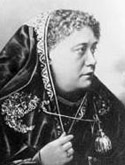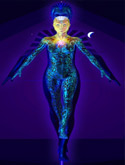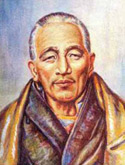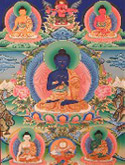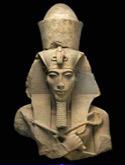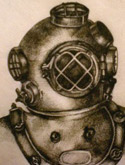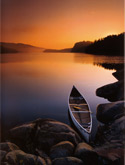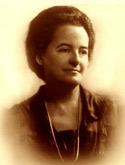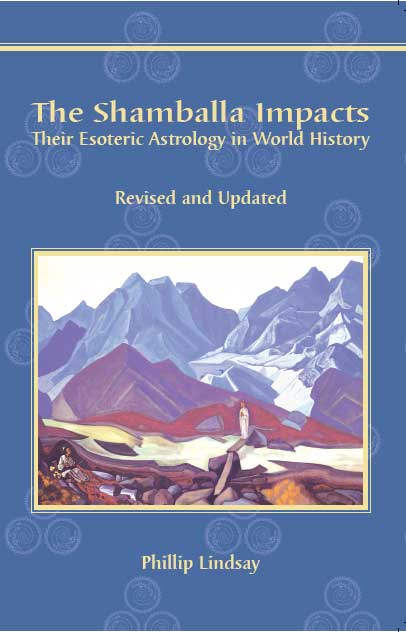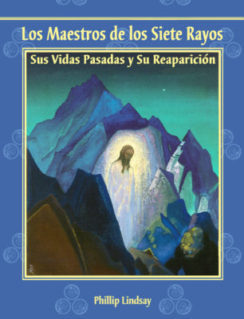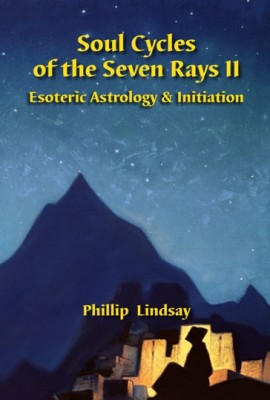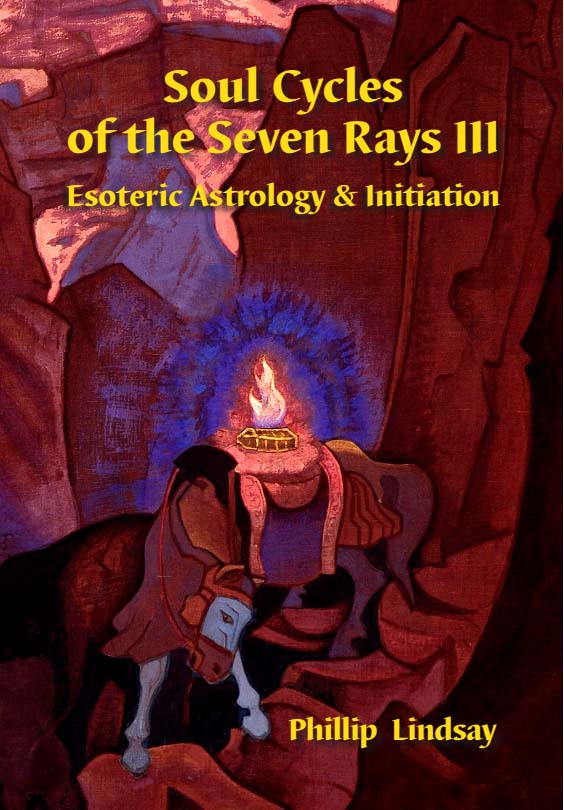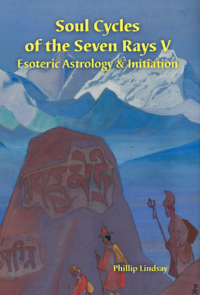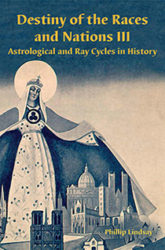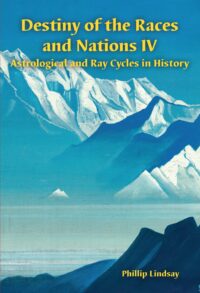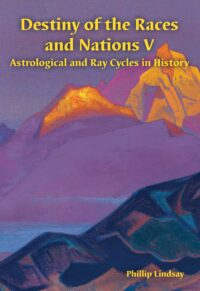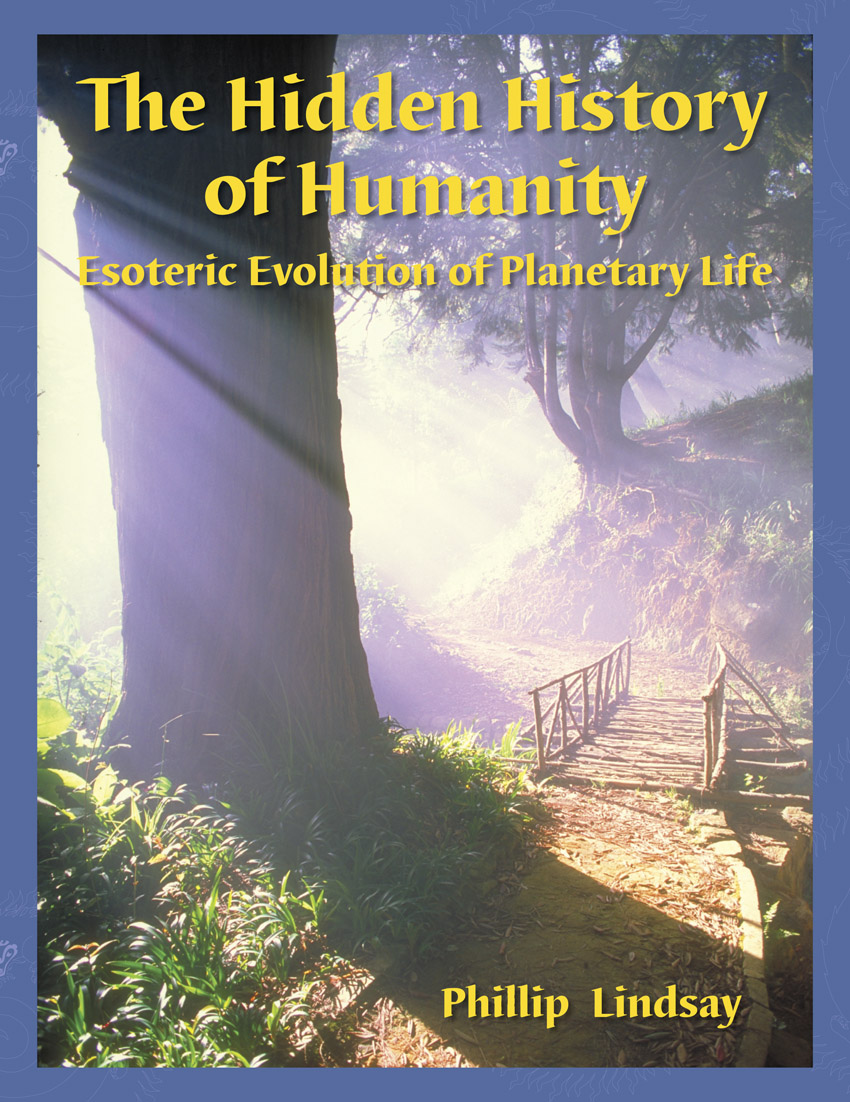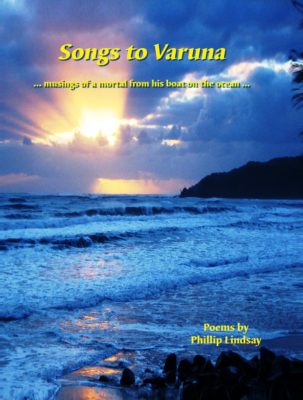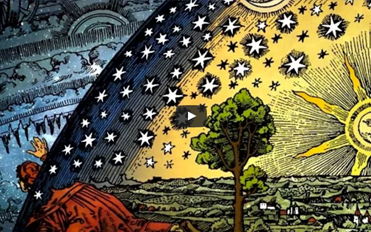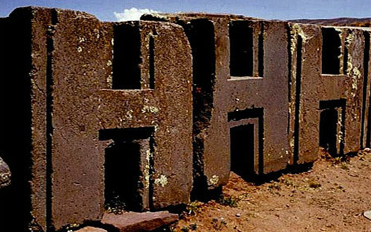
Matala, south coast of Crete. (Author’s pic)
Introduction
Crete as a Foundation of Europe
Crete, the Manu and Master Hilarion
The Temple of Knossos: The Minotaur’s Maze
Mt Idi: Birthplace of Zeus
Asger Lorentsen and The Golden Foundation
Leaving Greece
Introduction
Sailing across on the ferry from Athens to Crete gave a sense of excitement and expectation, as such voyages always do – a journey into the unknown, into the past, into some of the oldest mysteries that lay hidden in the mind of time.
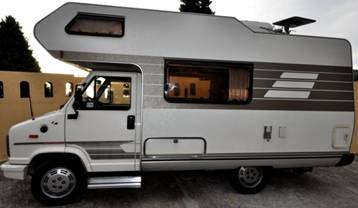
Monty muses entering a monastery near Rogdia. (Author’s pic)
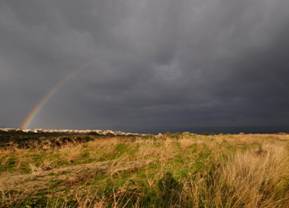
Rainbow over Rhythimno city. (Author’s pic)
Traveling in ever-trusty Monty the motor home, I spent a few months exploring and living on Crete, broken by a six week visit to the USA for the University of the Seven Rays annual conference in April 2011, before flying back to Crete, then driving back to some weeks later to Britain, via Greece and eastern Europe.
Although this is by no means considered a large motor home, it does have its challenges with narrow country lanes in Britain and now similarly in Crete. The best solution is to have a bicycle on the back or even a small motor bike.
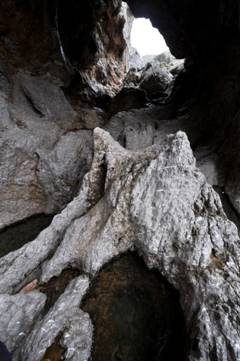
Cave, south coast Crete.(Author’s pic)
Crete is the fifth largest island in the Mediterranean, dominated by several large mountains that rise to about 8,000 ft (2,500 metres) – most notably Mt. Idi. It has some stunning coastlines and popular beaches that many Europeans flock to in the summer months, swelling the population by almost two million!

Matala sunset.(Author’s pic)
One of the first impressions about Crete is it’s ruggedness, its craggy rocks that are extremely hard to the touch; the goats who traverse these terrains are very Capricornian and Greece is a Capricorn personality. Another perspective here looks at the wider appeal of Crete to many visitors:
“Great layers of time hang gently on the shoulders of this Mediterranean island, whose harsh limestone landscape is everywhere softened by lush agriculture and passionate attitudes. Straddling the intersection of Europe, Africa and the Middle East, Crete has been a magnet for travelers since the Neolithic era and a conquering field for waves of Mycenaean, Roman, Venetian and Turk invaders.
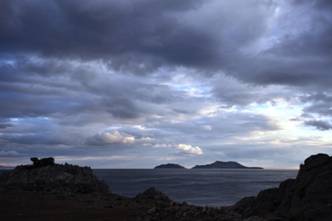
Craggy Cretan coastlines. (Author’s pic)
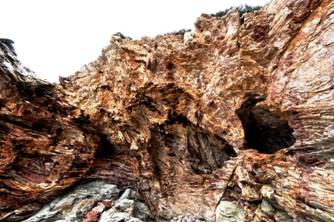
Craggy Cretan coastlines. (Author’s pic)
Minoan rulers, ensconced in gorgeously decorated palaces, played out sensuous soap operas that spawned the lusty gods of the Greeks. Their priestesses were wielding snakes … If not exactly Theseus, I nonetheless succumbed to the spell of this island elixir–a cocktail that combines the wild scent of oregano, the suppleness of olive oil and a hint of goddesses who still haunt the ancient groves. Drunk deeply enough, Crete could probably bestow eternal life. Sampled briefly, it leaves a permanent emotional tattoo.
All Cretan men smoke. All Cretan men are handsome (deeply, darkly handsome). All Cretan women really run the show. And this is as true in rambunctiously tacky Heraklion–with a population of 140,000, the largest center of arts and commerce on the island–as it is in the foothill villages where matriarchs gossip over pine-scented stoves.
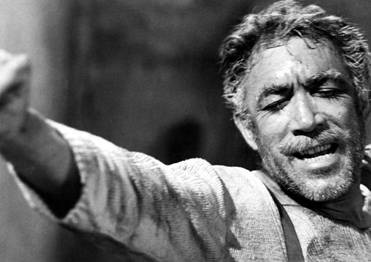
Oh the passion! Anthony Quinn as Zorba the Crete, er Greek.
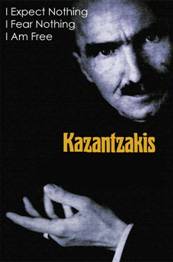
… Graceful, swirling and blatantly sexual, the men dominate the dancing–hands held high, moving with edgy grace, a gleam in each eye. But the real force of Cretan dance begins when the audience begins to join in. Sure, it’s like Zorba … it is impossible to listen to the hypnotic rhythms of Greek music and stay seated.”1
I was visiting here for all these reasons and indeed, wrote a piece about Nikos Kazantzakis, the creator of Zorba – in the astrological newsletter for Aquarius 2011.
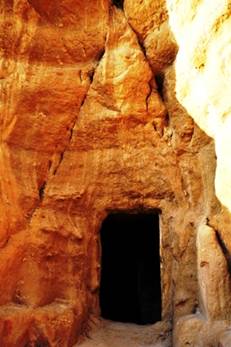
Tomb from the Roman era, Matala, southern Crete. (Author’s pic)
Crete as a Foundation of Europe
Yet the main reason for visiting Crete is that it holds a crucial part of the jigsaw in esoteric history. Eventually I had a major breakthrough in understanding, featured in my essay “Greek Mythology, The Secret Doctrine and the Rootraces” in The Destiny of the Races and Nations II.
The basic premise advanced in this essay is that Crete is the foundation of the fifth branchrace of the fifth subrace of the Fifth Rootrace – the 5.5.5. This concurs with the exoteric idea that Crete is where the first European civilization—the Minoan—thrived. Yet the time scales are vastly different – exoterically only a few thousand years, esoterically a branchrace is around 25,000 years!
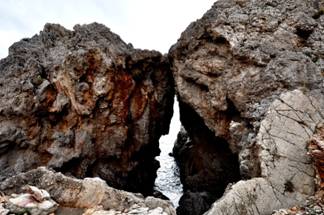
The twins, butting heads.(Author’s pic)
Hence Greece-Crete is proposed as the pioneer of this 5th branchrace, starting around 10,000 years ago – with another 16,000 years to run. Currently Britain and Northern Europe represent the highest development of this fifth branchrace in its unfoldment.
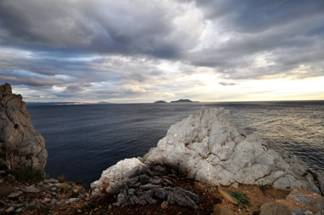
Seascape. (Author’s pic)
The political system of democracy (literally the ‘power of the people’), that started in Greece has found its highest expression in the developed nations of Europe, particularly Britain. North America, carrying the synthesis of Europe, represents the next step in the unfoldment of racial consciousness.
Crete, The Manu and Master Hilarion
Yet, in line with the 5.5.5 symbolism, it is fascinating to know that Master Hilarion, who is the Chohan or custodian of the Fifth Ray (Science) on this planet, is based on Crete. Indeed, he is known as the Cretan Master and is said to spend a lot of time in Luxor, Egypt with fellow Master Serapis.
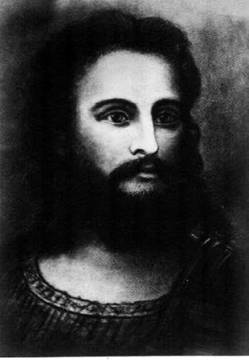
One of the better ‘impressions’ of the Master Hilarion.
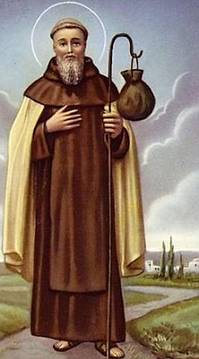
St. Hilarion of Gaza, a previous incarnation of H. (Died in Cyprus)
Crete and Egypt are very close to one another and parts of the Mediterranean Sea may have been land – when the Ancient Egyptians migrated from India during the second major flooding of Atlantis, 860,000 years ago. This geographical situation may account for the scattered remnants of the Pelasgians throughout mainland Greece, its islands, the Aegean Sea and surrounds.
“… the Hindu Manu, the thinking being, from man; the Egyptian Menes; and Minos, the King of Crete, judge of the infernal regions after his death—all proceed from the same root or word.”2
Hence, Crete’s association with both the Manu of the second subrace and one of the seven Chohans, makes it a very special place.
The Temple of Knossos: The Minotaur’s Maze

The Minotaur in Athens Archeological Museum. (Author’s pic)
The story of the bull in the minotaur’s maze runs basically thus:
“Minos prayed to Poseidon to send him a snow-white bull, as a sign of support. He was to kill the bull to show honor to Poseidon but decided to keep it instead because of its beauty. He thought Poseidon would not care if he kept the white bull and sacrificed one of his own.
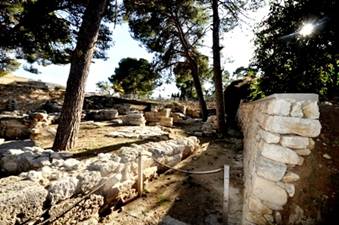
The ruins of Knossos. Note the bull’s horns. (Author’s pic)
To punish Minos, Aphrodite made Pasiphaë, Minos’ wife, fall deeply in love with the bull from the sea, the Cretan Bull. Pasiphaë had the archetypal craftsman Daedalus make a hollow wooden cow, and climbed inside it in order to “mate” with the white bull. The offspring was the monstrous Minotaur.
Pasiphaë nursed him in his infancy, but he grew and became ferocious, being the unnatural offspring of man and beast, he had no natural source of nourishment and thus devoured man for sustenance. Minos, after getting advice from the oracle at Delphi, had Daedalus construct a gigantic labyrinth to hold the Minotaur. Its location was near Minos’ palace in Knossos.”3
There are many interpretations of this myth, but one angle is connected to Taurus (the Bull) and its ruler (Aphrodite-Venus). The white bull could well be a symbol of the god Poseidon-Neptune incarnate – god and human, yet it is also the bull of desire who can only ‘feed’ on other humans.
However, Aphrodite-Venus is the ruler of the fifth ray of science or knowledge and the minotaur’s maze is beneath the palace of Knossos (knowledge, gnosis). Hence the minotaur represents the ‘dweller’ or shadow, the untamed mind when combined with the desire of the bull – becomes a ‘monster’. The minotaur’s maze is the labyrinthine ways of intellect and knowledge in which seekers can become lost and devoured by their own thoughtforms or dominated by their ‘dweller’.
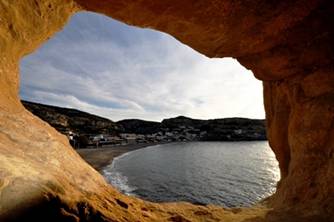
Inside out, Matala. (Author’s pic)

Elvis – rock star in the rock! (Author’s pic)
The original period for King Minos of around 860,000 years ago was a critical one because it was the genesis for the formation of the 2nd, 3rd and 4th subraces of the Fifth Rootrace – not just the 2nd subrace.4 The second submersion of Poseidon-ruled Atlantis had just occurred at this time and, it was the start of the Dvapara Yuga or age of Bronze for the Fifth Rootrace. (Dvapara: a mixture of purity and impurity, the age of doubt, all sacred things are halved.)
Hence, after 200,000 years of mental development in the first Hindu subrace (cradle of all the Western subraces that followed), there was plenty of baggage that had already accrued. The Minotaur in the labyrinth is a symbol of those accretions (as is acquisitive Taurus), with its appetites and need of appeasement – hence the sacrifice of seven youths and seven maidens every nine years. Of course, much can be made of the numerical symbolism here such as the seven stars of the Pleiades and the seven rishis of the Great Bear constellation, whilst 9 is the number of initiation.

Elegant Art of the Minoan Civilisation at Knossos, Crete: Bull Leaping (Author’s pic) (No doubt connected to the ancient virgin sacrifices. Note the enormous size of the bull, hinting at an age when there were larger breeds of these animals.)
It is interesting to note that the legend of Ariadne, where she finds her way out of the labyrinth with the aid of a thread, has been interpreted as,


“… the solving of a problem with multiple apparent means of proceeding – such as a physical maze, a logic puzzle, or an ethical dilemma – through an exhaustive application of logic to all available routes … This process can take the form of a mental record, a physical marking, or even a philosophical debate; it is the process itself that assumes the name.”5
Logic is that which has been developed in the Fifth Rootrace – logic, concrete mind, reasoning, analysis – province of the Venus-ruled fifth ray.

The minotaur’s maze is also the tortuous, twisting, testing tunnels of initiation, where the candidate for initiation is forced to run the gauntlet through dark and dank recesses, amid strange sounds and odors. The fear factor is severely tested and hence the power of the mind and reasoning faculties to control fear that arises in the astral body.
What is the difference between a maze and a labyrinth? One and the same many people will say, but enthusiasts state that to qualify as a maze, a design must have choices in the pathway but labyrinths have one pathway that leads inexorably from the entrance to the goal, albeit often by the most complex and winding of routes.
Note the word ‘choices’, perhaps the maze is of the lower mind whilst the labyrinth is of the soul? Yet if a person is sufficiently soul-centered, it will make the right choices in the maze.
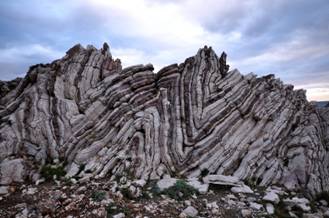
More ‘crazy pave’ from southern Crete. Shades of the maze… (Author’s pic)
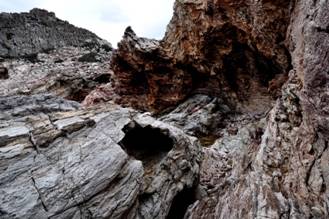
More ‘crazy pave’ from southern Crete. Shades of the maze… (Author’s pic)
Hence, whilst the monster at the centre of the maze may be the dweller, in the labyrinth is its opposite, the soul. Walking the labyrinth has a way of connecting us to our centre and finding soul purpose.
The labyrinth and maze are both symbols of the third ray of creative intelligence, from which the fifth ray is derived. (Even though the 4th ray is the only ray that comes through Taurus, this sign has many similarities to the third ray.)
Compared to other places like Eleusis and Delphi, Knossos hardly registered with me on the energetic scale; but of course this does not necessarily mean anything. To do the place justice, one would have to visit a few times to do a proper ‘psychic investigation’.
Mt Idi: Birthplace of Zeus
In ancient times the Idaean cave, “cave of the Goddess” (Dea) was venerated by Minoans but in later Greek times it was re-dedicated as the birthplace of Zeus; it was a cave of initiation and it may have even replicated the oracle as practiced at Delphi.
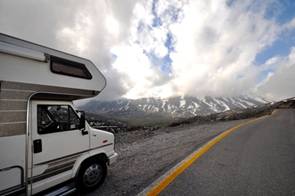
Chugging up Mt. Idi (Author’s pic)

Close up of some Mt. Idi vegetation.(Author’s pic)
Mt Idi is the highest mountain in Crete but a fairly easy drive. It was February, so there was plenty of snow toward the top. Stopping a few times for a stretch on the way, I noted how utterly quiet and remote it was, not even the sound of any birds, an eerie sensation. Zeus is a first ray archetype and I definitely knew I was in his domain!
Pythagoras, a previous incarnation of the Master Koot Hoomi, traveled to the Idaean cave and was initiated in rites connected to the birth and death of Zeus. Iambic writes how Pythagoras was purified by the application of meteoric stones in a ritual that required him to lie face down at dawn beside the sea; at night he lay beside a river, crowned with a wreath of black lambs wool and then, wrapped in the black wool, he entered the cave, staying in solitude for twenty-seven days.
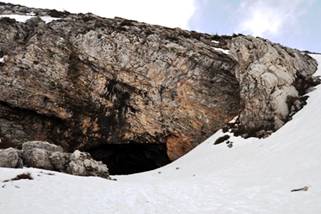
Idaen cave entrance
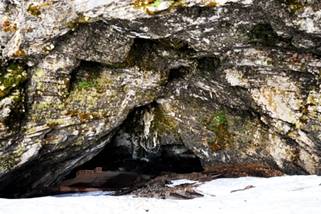
Idaen cave entrance
27 = 3 x 9 and 9 is the number of initiation, hence 27 represents the third degree initiation, of which Pythagoras was probably an exponent and may well have taken the initiation here at this site.
I walked up to the cave in about 2-3 ft of snow, and crawled to the entrance. The snow had crept some way into the cave, so I had to kind of slither over the top of the snow and slide sideways down into the grotto.

Looking back out.

That night was spent in the car park below and Zeus decided to whip up a bit of a storm. All night the wind howled and rain lashed the campervan; it rocked from side to side and I felt like I was on a ship at sea!
As I was lying in bed trying to get off to sleep, exhilarated by the Idaen cave and the fresh (freezing) mountain air, a beaming face zoomed into my consciousness. He was dressed in a beautiful blue tunic with golden braid or a necklace of some kind.
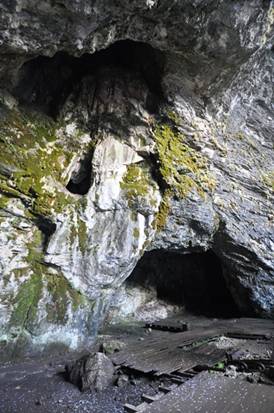
Dramatic view of the cave’s interior.
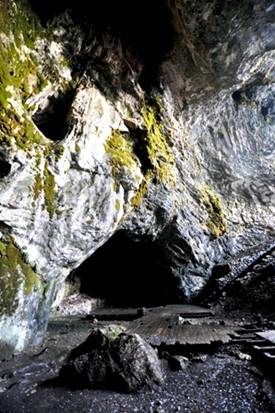
Dramatic view of the cave’s interior.
He wore a benevolent smile and no sooner had I become aware of his presence, he zoomed back from wherever he emerged. I dropped off to sleep immediately afterward with a blissful sense of protection, awoken occasionally through the night by the wind and rain rocking my ‘boat’.
Mt. Idi was definitely one of the high points of my visit to Crete, a great purity of energy there, so I will definitely re-visit in some future summer.
Asger Lorentsen and The Golden Foundation

 During my stay on Crete I was privileged to stay at The Golden Foundation, a meditation, healing and teaching retreat set up by Asger Lorentsen and his wife Yvonne Wassini from Denmark.
During my stay on Crete I was privileged to stay at The Golden Foundation, a meditation, healing and teaching retreat set up by Asger Lorentsen and his wife Yvonne Wassini from Denmark.
The site sits on a ridge above the city of Heraklion near the village of Rogdia, with terrific views of the Mediterranean. I stayed here for about three weeks, enjoying the rugged surrounds and hiking in the neigbouring hills and olive groves. Only a few other people were around as winter is not the most popular time of the year.
On January 21st this year, our dear brother Asger passed, a great shock to all who knew him. Asger had the Sun in Pisces and made a great contribution in merging the ageless wisdom teachings with mystical Christianity. He authored dozens of books and created a large country community retreat in Denmark that I visited in the winter of 2006.

The view over Heraklion from the Golden Foundation. (Photo of the Author.)
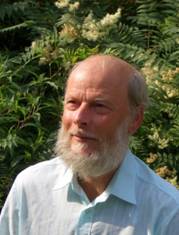
Asger Lorentsen (26.2.1947 – 21.1.2012)
I do not have Asger’s time of birth so his rising sign is unknown to me. However, he had Mars in Aquarius and Moon in Taurus, making him a tireless worker for the community and a manifestor of the ‘bricks and mortar’ needed for human living. Asger had a magnanimity that few possess, he was much admired and will be sorely missed.
Leaving Greece: Don’t Talk about the War6
There are many other places I visited on Crete, too numerous to mention, hence this short blog does not really the place or the people much justice. There were also many places that I did not go to – such a lot to see for a small island! I never visited the city of Hania where my Aussie great uncle Arthur fought in World War II and was captured by the Nazis. My mother described to me recently what happened:
“He was transported to a German camp near the Black Forest (Stalag VIII B as I recall). At the end of the war the gates of the camp were opened, machine gunners positioned and the men were lined up and told to march. The idea was to form a ring of POWs around Hitler’s bunker so the allies would not be able to get to him.
The POW’s were all starving and little Arthur fainted. A mate slung his seven stone [112 lbs. or 50 kgs.] over his shoulder and Arthur woke up lying on the floor of some army hospital with the RAMC (Royal Army Medical Corps) man demanding cigarettes to lift him on to a bed. He told me later RAMC stood for “Rob all my comrades”.”
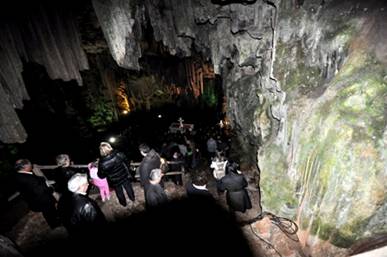
Melidoni Cave.(Author’s pics)
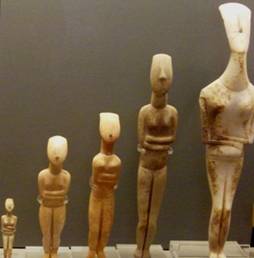
The very ancient Cycladia Idoleia (Author’s pics)
Crete has been the site of many sieges and battles over many millennia, not least with the dreaded Turks – with whom they have a long and painful history. The day I visited Melidoni cave, the site of an awful massacre of several hundred Cretans by the Turks, there was a large commemoration ceremony going on, with TV cameras, politicians, soldiers, choirs and tourists like myself – it was packed!
I made it back to Athens for a little while, then returned to Britain via eastern Europe. I had driven to Greece via Italy and the ferry five months before so decided a different route might be interesting. If I had known how much it was going to cost me in road tolls getting out of Greece, I would never have taken this route. After paying 80 Euros at about 20 toll booths, I finally made it to the Macedonian border where the border police slugged me for another 120 Euros. (‘If you don’t like it, then go back via Italy’, they said.)
After this big rort (200 Euros in one day), I was left with a bit of a sour taste in my mouth, so with a one finger salute in my rear vision mirror, I stepped on the gas saying, ‘see you later Greece, enjoy your recession!’

Gortys, southern Crete. (Author’s pics)
Later I was subject to an extensive search through the motorhome by customs officers, taking about 45 minutes as they poked into every corner of Monty’s innards, unpacked cupboards and suitcases, unscrewed jars of food. Sorry guys, 35 years ago you may have been in luck but not today!

(He)phaestos, southern Crete. (Author’s pics)
With another digit raised in my rear view mirror, I then proceeded through the perfectly medieval eastern Europe, very beautiful in parts, yet with somewhat haunting, lingering mysteries and pain from centuries past. Through Serbia, Bosnia, Croatia – then on to Slovenia, Hungary, Austria, Germany and France – in three days (sleeping every night), the same time it took me to drive from London to Athens via Italy.
I found Serbia and Bosnia a little chilling, driving through some towns that still bore the scars of the conflict in the 1990’s. Houses burnt out by murderous neighbours were still standing as grim reminders in between the inhabited houses. I remember dreaming about these horrors in the ’90’s, wondering how people could do this to each other in the name of religion. I remembered discussing the situation at the time with my osteopath in Sydney, the son of Serbian parents.
Then, on May 26, 2011, as I was driving through Bosnia, listening to an English speaking radio station, I heard on the news that the Serb general Ratko Mladic had been arrested, a coincidence that compounded my earlier ‘chills’ of revisiting those memories of the 1990’s.

Temple of Knossos. (Author’s pics)
I did not find eastern Europe that friendly, though of course this was just through the eyes of roadside stopovers and service stations. Hardly anyone spoke English either, which was surprising. It was a relief to finally get on the autobahn in Germany, no more tolls, smooth traveling and a little more ‘civilised’; though ironically the fascism and cruelty of the Balkans occurred only 50 years after the fascism of Germany.

Flowers at Melidoni. (Author’s pics)
I recalled the village I drove through (Anogia, Crete) where the Germans slaughtered everyone in WWII; several other towns in Crete suffered the same fate. Its interesting now to reflect upon Germany’s current relationship with Greece and the so-called ‘bail-outs’.
On the autobahn I was passed by BMW’s, Audi’s and Mercs jetting past at about 160 m.p.h. or more – while I was puttering along in old Monty doing about 60 mph. I would suddenly hear a loud ‘vroom’ as they sped past, leaving a gust of wind in their wake that would rock the van from side to side.
Without much further ado, France, Belgium and I was back on the ferry in Dunkirk and over to Britain. The next day I was in a car park outside a motor accessory shop tinkering with the camper, cleaning it up to sell. An older gentleman walked past and started talking to me about it and I said ‘oh by the way, its for sale’.
He had not even been looking for a camper, but realised that it would be perfect to travel back to his holiday house in France, so the next day he had the van, I was ‘holdin’ foldin’, bought a plane ticket and returned to Australia.

St. Titus church, southern Crete. (Author’s pic)

Welcoming party at a famous place whose name I forget! (Author’s pic)
It was one of the worst flights of my life as I never sleep that well anway, the night before I go on a long flight. Then there was a twelve hour layover in Brunei (my birth place coincidentally), all up, due to unforseen strong tea, unable to sleep for 56 hours, hanging by a thread when I returned. After staying in Australia for one month I headed back out to the USA and South America – from where I have just returned, now back in Australia – June 2012.
Sometimes I have trouble remembering where I am and I know my friends and family definitely have trouble keeping up! When I come to Australia now, I feel like a visiting backpacker in my own country – an Austr-alien, turned world traveler/citizen. (I am now also a British citizen so have access to all of Europe.). Sometimes I will wake up, trying to figure out where I am – it might take ten minutes or half an hour to work it out in my half sleep state. Am I in Lima, Los Angeles or La Paz? Well it has not yet reached the stage of asking ‘what planet am I on’, but it may very well!
Phillip Lindsay © 2012.
Origins Odyssey: Travel Diary#1 – Britain 1. 2010
Origins Odyssey: Travel Diary#2 – Britain 2. 2010
Origins Odyssey: Travel Diary#3 – Costa Rica, Greece 2010
Origins Odyssey: Travel Diary#4 – Greece & Crete 1. 2011
Origins Odyssey: Travel Diary#5 – Greece & Crete 2. 2011
Origins Odyssey: Travel Diary#7 – India-Sri Lanka. (Prequel 1: 1992)
Origins Odyssey: Travel Diary#8 – Egypt (Prequel 2: 2007)
Books by Phillip Lindsay

